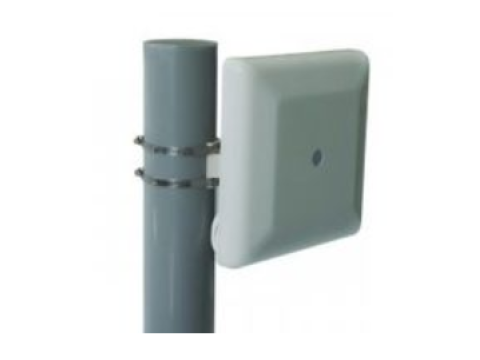Radio-wave (microwave) security sensors use the Doppler effect to detect movement in protected areas. While less common than infrared (PIR) detectors, they excel in certain environments where light interference or heat currents might cause false alarms for IR sensors. Below, we’ll discuss the advantages, types, and installation considerations for microwave intrusion detectors.
Principle of Operation
Radio-wave sensors (often called microwave detectors) transmit and receive high-frequency signals. If an object moves within the detection zone, the reflected signal shifts in frequency (the Doppler effect). A processor measures this frequency shift and triggers an alarm if it surpasses a threshold.
Pros & Cons
Advantages
- Immune to light interference: Bright sunlight, car headlights, or flashlights won’t cause false alarms.
- Unaffected by heat convection: HVAC vents or radiators won’t trigger it.
- Penetrates non-metal barriers: Furniture or thin partitions may not create dead zones, giving broad coverage.
Drawbacks
- May detect beyond intended area: Microwave signals can pass through walls, doors, or windows, potentially triggering false alarms if someone moves outside the monitored zone.
- Susceptible to external RF noise: Strong electromagnetic fields can disrupt operation.
- More expensive and sometimes more difficult to fine-tune than IR devices.
Types of Radio-Wave Sensors
1. Volumetric (Indoor/Outdoor Motion)
Ellipsoidal “Bubble” Zone:
- The detection field is typically a 3D ellipsoid or near-spherical “bubble.”
- Some sensors allow subdividing this volume into multiple “subzones,” enabling zone shaping or selective disablement.
Power & Wiring:
- Either powered via a dedicated power supply (4-wire: 2 for power, 2 for relay output) or via the alarm loop (2-wire if they use increased current draw to signal the control panel).
- Common coverage distances range from 30 to 60 meters (100–200 feet) in open areas.
Indoor Usage:
- Large open rooms with minimal partitions, since microwaves can pass through non-metal barriers.
- Must avoid placing two microwave sensors too close on the same frequency—interference might occur.
2. Linear (Perimeter) Sensors
One-Position (Single-Ended)
- Transmitter and receiver share the same housing.
- The sensor monitors a “beam” extending out from the device.
- Simpler installation than a two-piece system.
Two-Position (Bi-Static)
- Separate transmitter and receiver block face each other.
- Potentially longer range—ideal for outdoor perimeters or large open expanses.
- Often used for fence-line or boundary detection, requiring minimal false alarms and robust weather tolerance.
Buried or Cable-Based
- A radio-sensitive cable is laid along a fence or in the ground to detect disturbances.
- Highly flexible for irregular perimeters, multiple turns, or varying terrain.
- Sturdy in adverse weather (rain, snow, dust).
Indoor vs. Outdoor Usage
Indoor
- Advantageous when IR sensors might be triggered by lighting changes or heat flows.
- Risk of detecting motion behind thin walls, requiring careful placement.
- Potential electromagnetic interference from large machinery or dense wiring can degrade performance.
Outdoor
- Deployed for perimeter protection—often linear or cable-based solutions.
- Generally resilient to fog, rain, and moderate snow, although installation guidelines often require a “clear zone” free of tall vegetation or random debris.
- Terrain and landscaping must be relatively stable to reduce false alarms from moving branches, gates, etc.
Installation & Mounting Tips
Plan Coverage
- Be mindful of the sensor’s stated range and angle.
- For volumetric devices, ensure no large obstructions or high metal content walls hamper signals.
- For linear/bistatic sensors, keep the path between transmitter and receiver clear and level.
Avoid Interference
- Use different frequency channels (frequency “letters” or “bands”) if installing multiple microwave sensors nearby.
- Steer clear of high-power RF sources, like industrial welders, radio transmitters, or large transformers.
Minimize Vibrations
- Mount on solid walls or poles to avoid sensor shake—vibrations can cause false Doppler shifts.
- Secure cables and housings to reduce motion in wind or heavy rain (especially for outdoor installations).
Power & Wiring
- Many microwave detectors draw hundreds of milliamps—a dedicated power supply is recommended.
- Voltage drop across long cables can be significant; use suitably gauged wire and confirm that voltage at the sensor meets specifications.
Signal Output & Communication
- Traditional sensors offer relay outputs (“dry contacts”) for a typical 4-wire setup.
- Others provide digital or RS-485 communication for addressable alarm systems.
- Some advanced models incorporate Bluetooth or other wireless modules for configuration or data streaming.
Practical Examples
Warehouse Volumetric Detection
- Large open floor plan with minimal partitions.
- Microwave sensors can cover wide areas where IR might have multiple blind spots.
Fence-Line or Boundary Protection
- Two-position linear microwave sensors create a “virtual beam” along the property border.
- Or bury a radio-sensitive cable (triboelectric style) for covert perimeter detection.
High EM Noise Environments
- Factories or industrial plants might require IR detectors instead, unless carefully tested to confirm microwave reliability.
Conclusion
Radio-wave (microwave) security sensors can be indispensable for specific intrusion-detection scenarios—covering large open areas or providing reliable perimeter lines, even in low-visibility conditions. However, they require careful planning to avoid false alarms from detecting motion behind walls or mutual interference with neighboring sensors.
Key Takeaways:
- Volumetric microwave detectors serve large indoor spaces or open outdoor fields.
- Linear or bistatic sensors excel in perimeter or fence-line defense.
- Installation demands ensuring stable mounts, controlling vegetation, and pairing sensors on different frequency channels if placed closely.
- Power requirements can be higher than IR sensors, necessitating robust power lines and verifying voltage drops.
For expert guidance on selecting and installing radio-wave security sensors, visit safsale.com. Our professionals can help with system design, frequency allocation, and best-fit solutions to ensure reliable coverage with minimal false alarms—indoors or out.

